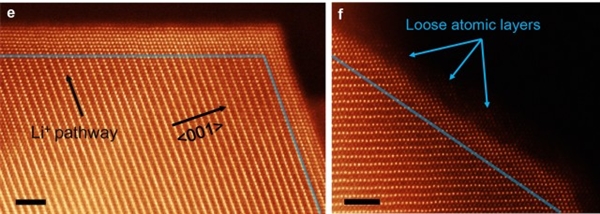Nanocrystals make batteries use less battery power
 |
The durability of the battery has always been very confusing for researchers, because no matter how large the battery capacity, if you can not repeat multiple times it does not make sense. We all know that lithium batteries will decrease in capacity as they are used, but no one has ever known why. Recently, the U.S. energy agency discovered the cause of battery aging: nano-sized crystals.
Scholars have carefully studied the materials of cathode and anode of modern batteries. They found that these materials are directly corroded during use, but the mechanism of corrosion has not yet been clarified. The team at Brookhaven National Laboratory observed high-quality nickel-oxygen cathodes by transmission electron microscopy and recorded their changes during repeated charge and discharge.
This experiment shows that when lithium ions pass through the anode and cathode, they will “snap†in the ion channels. They will react with nickel oxides and generate tiny crystals. These crystals change the internal structure of the battery and make other ions unable to react efficiently, thereby reducing the available battery capacity. Surprisingly, such weakness is random and there is no law at all.
The reason why lithium batteries are not perfect is that the components of the battery are not perfect. No matter how much we pay attention to the structure of the cathode and anode, tiny damage will produce crystals. Just like when water is boiled, uneven surfaced containers make it easier for hot water to bubble up. It can be said that as long as the battery material is notched, nanocrystals will be produced.

The arrow on the left indicates: the lithium ion channel; the right picture shows the atomic loss layer
The U.S. Energy Agency also initiated a second study to explore the impact of charging speed on battery capacity. They found that modern batteries are getting smaller and smaller, which in turn will shorten the battery life. The larger the volume of the battery, the faster the charging speed and the slower the formation of nanocrystals.
So what methods can prevent the production of nanocrystals? At least make this process slower. There is a theoretical solution. Scholars have discovered that with an atomic deposit, it can fill the defects of battery materials, which can at least slow down the production of nanocrystals. Although this approach does not fix the symptoms, it can at least allow the batteries to be reduced in size without sacrificing durability. Of course, scholars are also trying to break these crystals and let the old batteries "rebirth."
This research may be worth more than adding battery capacity. For hardware, the life of the product depends on how many times they can charge and discharge. At present, many hardware use non-removable power systems, this study may allow us to no longer be "electric slaves."
An agent that causes weeds to dry out either completely or selectively.This kind of product can eliminate or inhibit the growth of plants.
White crystalline powder;For corn and potato weeding;
Used for annual or perennial gramineae and broad-leaved weeds in corn fields.
It has special effects on barnyard grass. It can be used to prevent weeds and weeds that are resistant to other herbicides.
Crystalline Powder Rimsulfuron,Herbicides Rimsulfuron,Crops Control Rimsulfuron,Weedicide Rimsulfuron
Hebei Senton International Trading Co.,Ltd. , https://www.sentonpharm.com